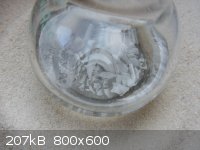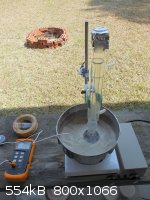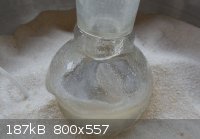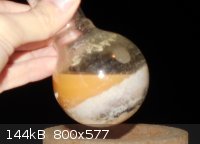| Pages:
1
..
49
50
51
52
53
..
66 |
blogfast25
International Hazard
    
Posts: 10562
Registered: 3-2-2008
Location: Neverland
Member Is Offline
Mood: No Mood
|
|
Quote: Originally posted by elementcollector1  | | I poured isopropanol over the mix in a futile attempt to clean the strainer (too big to submerse in alcohol, but couldn't hold any of the liquid
either), and several small bits of K rose to the surface, quickly reacting. And then they caught fire. |
Part of your problem was that there wasn't much liquid about. When the K starts reacting with the alcohol, heat is generated, say ΔH. This heats
up the liquid acc. ΔH = m c ΔT, with m mass of liquid, c heat capacity of liquid and ΔT the temperature rise. When m is small, ΔT
is larger. Presumably you exceeded the flashpoint of the alcohol/kero mix. And higher ΔT also accelerates the reaction: runaway!
To avoid this in the future, slowly dump all your suspected K into a larger volume of alcohol, stirring continuously. The greater alcohol mass will
then not heat up so much.
What do you mean by a 'bubbler' in this context?
[Edited on 17-3-2013 by blogfast25]
|
|
|
Lambda-Eyde
National Hazard
   
Posts: 857
Registered: 20-11-2008
Location: Norway
Member Is Offline
Mood: Cleaved
|
|
It was an improvised bubbler, made by attaching a tubing adapter to the top of the vigreux, and leading a hose into a beaker of water, in order to
keep additional air out. It was probably overkill, but I thought it couldn't hurt.
This just in: 95,5 % of the world population lives outside the USA
You should really listen to ABBAPlease drop by our IRC channel: #sciencemadness @ irc.efnet.org
|
|
|
Sublimatus
Hazard to Others
  
Posts: 108
Registered: 8-6-2011
Member Is Offline
Mood: No Mood
|
|
One could always use a balloon to achieve the same effect, assuming the increase of gas volume inside the apparatus won't be too great.
|
|
|
elementcollector1
International Hazard
    
Posts: 2684
Registered: 28-12-2011
Location: The Known Universe
Member Is Offline
Mood: Molten
|
|
I think we decided against balloons a while back. I used Al foil wrapped fairly tightly around the top of the condenser.
Elements Collected:52/87
Latest Acquired: Cl
Next in Line: Nd
|
|
|
blogfast25
International Hazard
    
Posts: 10562
Registered: 3-2-2008
Location: Neverland
Member Is Offline
Mood: No Mood
|
|
The whole 'perforated balloon' idea rests on the assumption that some material (low boilers from the solvent?) escapes, thus keeping the
balloon inflated and any air out. But if there really is such an updraft then it purges the apparatus of air anyway. And if there's not, this
primitive septum is unlikely to keep anything out. It's a colourful waste of effort, in short.
The only way to work fully anaerobically is to fully purge the apparatus with O2 free argon or nitrogen and keep a low flux of either throughout the
reaction. This has been shown conclusively not to be necessary.
[Edited on 18-3-2013 by blogfast25]
|
|
|
elementcollector1
International Hazard
    
Posts: 2684
Registered: 28-12-2011
Location: The Known Universe
Member Is Offline
Mood: Molten
|
|
Just cut through a ball of potassium today to make it fit in a test tube. The metal was very silvery... for about 10 seconds. Now it's whitish and
bluish. Also switched solvents from mineral oil to lamp oil, so now all my potassium spheres are more whitish than silverish in color. I'll probably
just clean them when I'm coalescing stuff from the final demo...
Anyway, the extremely good news is, my coach ordered 100mL of tert-butanol from Sargent-Welch as an "official Science Club chemical", so coupled with
a good source of magnesium and potassium hydroxide, if I wanted, I could either scale this synthesis way up or do it a lot. Or examine the properties
of the tert-butanol itself.
I should get him to order chemicals through the club more often... 
Elements Collected:52/87
Latest Acquired: Cl
Next in Line: Nd
|
|
|
blogfast25
International Hazard
    
Posts: 10562
Registered: 3-2-2008
Location: Neverland
Member Is Offline
Mood: No Mood
|
|
Perhaps you could try and make some k t-butoxide from K and your t-butanol, and see how it reacts in 'pok's conditions' with Mg? That would be a novel
contribution to this thread.
|
|
|
elementcollector1
International Hazard
    
Posts: 2684
Registered: 28-12-2011
Location: The Known Universe
Member Is Offline
Mood: Molten
|
|
Quote: Originally posted by blogfast25  | | Perhaps you could try and make some k t-butoxide from K and your t-butanol, and see how it reacts in 'pok's conditions' with Mg? That would be a novel
contribution to this thread. |
Hmm. That might be something to do. Wouldn't I have to re-calculate the mass of K-t-butoxide to use? Should be a 1:1 mole ratio.
But wait - isn't there water needed to regenerate the catalyst from the Mg-t-butoxide? Or does the catalyst not need to be regenerated?
Elements Collected:52/87
Latest Acquired: Cl
Next in Line: Nd
|
|
|
blogfast25
International Hazard
    
Posts: 10562
Registered: 3-2-2008
Location: Neverland
Member Is Offline
Mood: No Mood
|
|
There is no ‘regeneration of the catalyst’ in that case, because there's no catalyst. The reaction simply becomes:
2 K t-BuO(dissolved) + Mg(s) === > 2 K(l) + Mg(t-BuO)2(?)
With magnesium t-butoxide as one of the end products.
One of the embodiments of the patent deals with reducing an alkali metal t-butoxide with magnesium but I forget what alkali metal they used.
Edit: in fact it was potassium t-amylate they used:
http://www.freepatentsonline.com/4725311.html
Example 3.
[Edited on 19-3-2013 by blogfast25]
|
|
|
Lambda-Eyde
National Hazard
   
Posts: 857
Registered: 20-11-2008
Location: Norway
Member Is Offline
Mood: Cleaved
|
|
Quote: Originally posted by blogfast25  | | Perhaps you could try and make some k t-butoxide from K and your t-butanol, and see how it reacts in 'pok's conditions' with Mg? That would be a novel
contribution to this thread. |
This has been a plan of mine for a long time. Doing this reaction successfully would definitely prove that the intermediate is the K butoxide. Only
problem is that I haven't had success with the reaction yet.
This just in: 95,5 % of the world population lives outside the USA
You should really listen to ABBAPlease drop by our IRC channel: #sciencemadness @ irc.efnet.org
|
|
|
blogfast25
International Hazard
    
Posts: 10562
Registered: 3-2-2008
Location: Neverland
Member Is Offline
Mood: No Mood
|
|
Quote: Originally posted by Lambda-Eyde  |
This has been a plan of mine for a long time. Doing this reaction successfully would definitely prove that the intermediate is the K butoxide. Only
problem is that I haven't had success with the reaction yet. |
What do you have in mind to synth the K alkoxide?
|
|
|
Lambda-Eyde
National Hazard
   
Posts: 857
Registered: 20-11-2008
Location: Norway
Member Is Offline
Mood: Cleaved
|
|
The plan is to first succeed in the potassium synthesis, then quench the potassium with t-BuOH in parafin (or any other suitable solvent), and then
run the reaction with the solution (or dispersion) in order to minimize the degradation of the butoxide.
This just in: 95,5 % of the world population lives outside the USA
You should really listen to ABBAPlease drop by our IRC channel: #sciencemadness @ irc.efnet.org
|
|
|
MrHomeScientist
International Hazard
    
Posts: 1806
Registered: 24-10-2010
Location: Flerovium
Member Is Offline
Mood: No Mood
|
|
Over a year since I first posted on this topic expressing my interest, I am finally nearly ready to attempt this experiment myself! It took quite a
while to get the right equipment and chemicals (particularly a good hot plate and the t-butanol).
I have spent the last few days reading the entire thread (yes, the WHOLE thing!) to review the progress of others. I copied the bits and pieces I
found useful and put them in a Word document, which I've attached here in case anyone else might find it helpful. It's quite long itself, but at least
shorter than 51 pages! Don't be offended if your posts didn't make the cut, or if I misattributed some peoples' ideas - I was simply looking for
information relevant to my own plans for this experiment and this was just a quick notepad for myself. I just figured others might benefit from my
tired eyes  There's lots more great information here, and the document is really
no substitute for reading the thread in its entirety. There's lots more great information here, and the document is really
no substitute for reading the thread in its entirety.
Attachment: Potassium Synthesis Notes.docx (325kB)
This file has been downloaded 1151 times
==========================
Anyways what I really wanted to report is that for my solvent, I purchased some Lamplight Ultra-Pure Lamp Oil (MSDS) from a local arts and crafts store. They were unfortunately out of the colorless variety, so instead I bought one dyed blue. I figured the
dye shouldn't interfere, and there wouldn't be much in there anyway.
First thing's first: I assembled my setup to test the hot plate. I don't have a thermometer that goes high enough, so I wanted to test if I was able
to boil the solvent (which would give me an idea if my hotplate is suitable). A thermocouple is in the mail, but we'll see when it actually gets here.
Apparatus: a sand bath covering a 24/40 100mL RBF containing 50mL of the oil, and connected to a liebig condenser (with nothing connected to it, just
cooled by ambient air). I slowly brought the temperature up to 9/10 on the knob, and observed that mirage-like effect of convection in the liquid. It
never boiled, but handily enough the blue color slowly faded! By the time I took it off heat, it was completely colorless. This was about 3 hours
later - unless I'm doing something wrong, sand baths take forever to heat up!
I also did another trial with the exact same setup, except adding carbon boiling chips. This time a very slow boil was observed (about 1.5 bubbles /
sec). Condensation was observed at the very bottom of the condenser (not even up to the jacket). This means that my plate should be able to reach the
necessary temperature. This batch had a slight yellow tinge to it, probably from carbon particles. Hopefully those will have settled next time I check
on it. Carbon shouldn't interfere, but I'll at least run it through a filter.
A question on the sand bath, though, as I've never used one before. Should temperature be slowly turned up, or is it alright to go straight to max
setting? I've seen some hot plates warn against using sand baths on them - what's the reasoning on that, and is there anything I should do to mitigate
the risks?
Hopefully I'll be set to try this out this weekend. I'll use the decolorized lamp oil in my first trials.
[Edited on 3-26-2013 by MrHomeScientist]
|
|
|
elementcollector1
International Hazard
    
Posts: 2684
Registered: 28-12-2011
Location: The Known Universe
Member Is Offline
Mood: Molten
|
|
Not sure, as my hot plate could take both ways. Turning it all the way up seems like the best idea, just to save time. Then again, it was a Corning
hotplate with stirring.
What's your sand bath? I used a stainless pot full of beach sand, and it worked pretty well.
Your dye was probably destroyed by heat - interesting...
What's your hot plate, anyway?
Elements Collected:52/87
Latest Acquired: Cl
Next in Line: Nd
|
|
|
MrHomeScientist
International Hazard
    
Posts: 1806
Registered: 24-10-2010
Location: Flerovium
Member Is Offline
Mood: No Mood
|
|
My hot plate was a recently-bought eBay auction, a "Thermolyne Nuova II Hot Plate Stirrer Model SP18425." It was some type of estate sale, you could
tell they didn't really know what it was 
I use the same setup for my sand bath, except my sand was taken from the excess bricklaying material from a nearby house under construction.
Interestingly, after taking my flask out of it I saw a lot of glittery flakes adhering to the glass that reminded me of mica. Might be a component of
mortar.
By the way I forgot to mention: Nurdrage has apparently taken down all his potassium synthesis videos (both the synthesis and coalescence
experiments). Why would he do this? I was hoping to use them to help me prepare.
|
|
|
Mailinmypocket
International Hazard
    
Posts: 1351
Registered: 12-5-2011
Member Is Offline
Mood: No Mood
|
|
I think sandbaths can confuse the hotplate's thermostat (if it has one) and cause it to overheat and burn out. The manual for my hotplate says to not
heat metal vessels directly on the "pyroceram" surface, nor to heat sandbaths. I'm not the expert on hotplate's though so maybe other members could
confirm if this is why sandbaths are not recommended. A cheap kitchen hotplate with coil element might be a safer option if in doubt...
|
|
|
blogfast25
International Hazard
    
Posts: 10562
Registered: 3-2-2008
Location: Neverland
Member Is Offline
Mood: No Mood
|
|
Nice idea to summarise this long thread, Mr HS, long overdue IMHO...
And get that thermocouple in there: w/o it you're driving blindfolded, so to speak. Temperature is too important a factor here to leave it to chance.
[Edited on 26-3-2013 by blogfast25]
|
|
|
elementcollector1
International Hazard
    
Posts: 2684
Registered: 28-12-2011
Location: The Known Universe
Member Is Offline
Mood: Molten
|
|
Quote: Originally posted by MrHomeScientist  | My hot plate was a recently-bought eBay auction, a "Thermolyne Nuova II Hot Plate Stirrer Model SP18425." It was some type of estate sale, you could
tell they didn't really know what it was 
I use the same setup for my sand bath, except my sand was taken from the excess bricklaying material from a nearby house under construction.
Interestingly, after taking my flask out of it I saw a lot of glittery flakes adhering to the glass that reminded me of mica. Might be a component of
mortar.
By the way I forgot to mention: Nurdrage has apparently taken down all his potassium synthesis videos (both the synthesis and coalescence
experiments). Why would he do this? I was hoping to use them to help me prepare. |
I really don't know why he took down the video. K3wls? Noobs? Apparently his flash powder is down too, so that's what I'd expect.
Mica, huh? Interesting. I used to be a mineral collector.
The coiled hotplate is a no-no, from my experience. It contributed to 6/7 of my failures. Use something stronger.
Elements Collected:52/87
Latest Acquired: Cl
Next in Line: Nd
|
|
|
blogfast25
International Hazard
    
Posts: 10562
Registered: 3-2-2008
Location: Neverland
Member Is Offline
Mood: No Mood
|
|
Nurdrage is moving jobs and will not have the use of that laboratory his current employer kindly allowed him to use for the Nurdrage channel. He's now
bidding for donor money to try and establish something independent. All this might have something to do with it.
|
|
|
MrHomeScientist
International Hazard
    
Posts: 1806
Registered: 24-10-2010
Location: Flerovium
Member Is Offline
Mood: No Mood
|
|
But then why only take down some videos, and not all? Also his Instructibles page on potassium remains up, but the video link in it is broken. Very
strange to me.
To come somewhat back on topic, I tried filtering my second batch of oil but the light yellow color remains. Probably miniscule carbon particles my
paper can't catch. Also, interestingly I seem to have "reodorized" my deodorized lamp oil by heating it...
|
|
|
blogfast25
International Hazard
    
Posts: 10562
Registered: 3-2-2008
Location: Neverland
Member Is Offline
Mood: No Mood
|
|
Quote: Originally posted by MrHomeScientist  | | To come somewhat back on topic, I tried filtering my second batch of oil but the light yellow color remains. Probably miniscule carbon particles my
paper can't catch. Also, interestingly I seem to have "reodorized" my deodorized lamp oil by heating it... |
Just try it: if anything is to be learned from the whole thread it's that the reduction is fairly robust with respect to the solvent used.
|
|
|
elementcollector1
International Hazard
    
Posts: 2684
Registered: 28-12-2011
Location: The Known Universe
Member Is Offline
Mood: Molten
|
|
Blogfast succeeded with lemon-flavored oil; I think a few particles of carbon won't do much to your reaction.
(Seriously, that's going to be an eternal joke for me. Lemon-flavored potassium.)
Elements Collected:52/87
Latest Acquired: Cl
Next in Line: Nd
|
|
|
MrHomeScientist
International Hazard
    
Posts: 1806
Registered: 24-10-2010
Location: Flerovium
Member Is Offline
Mood: No Mood
|
|
I know, I'm really not concerned about the stuff in the oil. I just like to eliminate potential uncertainties whenever I can, especially because
there's been so many failures on this experiment. Really, using the blue oil straight out of the bottle probably won't hurt anything. My next concern
is that my oil has a listed boiling point of 250+ C, so there may not be much agitation going on at the reaction temperature. I'll occasionally swirl
the flask if this is the case. Thermocouple is in the mail, but it probably won't make it here by the weekend.
|
|
|
blogfast25
International Hazard
    
Posts: 10562
Registered: 3-2-2008
Location: Neverland
Member Is Offline
Mood: No Mood
|
|
Occasionally swirling should be just fine. Remember that if the reaction proceeds, hydrogen will evolve, providing also a modicum of turbulence.
|
|
|
MrHomeScientist
International Hazard
    
Posts: 1806
Registered: 24-10-2010
Location: Flerovium
Member Is Offline
Mood: No Mood
|
|
First Attempt: Failure!
My thermocouple arrived much sooner than expected, so I was able to try this out today. I somewhat followed the procedure on Woelen's page, with the
exception of adding the alcohol all in at the beginning (the so-called "one pot").
In a 100mL RBF, the following were mixed:
- 7.0g KOH flakes
- 3.5g Mg granular powder (~80 mesh)
- 0.8mL tert-butanol
- 50mL deodorized and decolorized lamp oil (see my previous post about the oil pre-treatment)

You can see the Mg is a fairly coarse powder. This was connected to a condenser and placed in a sand bath. I put a layer of aluminum foil on top of
the condenser with two small holes poked in it, to allow for hydrogen escape and to attempt to exclude air. The thermocouple was stuck in the sand
near to the flask, so the temperature recorded is probably not the reaction temperature.

Shortly after the thermocouple read 100 C, about 20 minutes into heating, copious amounts of white smoke bubbled out of the liquid. Much of this blew
out the holes in the top of the condenser, and you can see that in the picture. This completely vanished 2 minutes later.

After the smoke dissipated, the solution gently bubbled throughout the remainder of the run. The solid contents initially appeared to "fluff up" quite
a bit, likely to be dehydrated KOH. About 45 minutes in, the temperature read around 200 C, and I fiddled with the dial to keep it there for the rest
of the run. (The max temperature I saw at any point was about 225 C.) I swirled the flask once, gently, around this time.
An hour and a half in, a white crust started appearing around the sides of the flask and as a little island in the middle. I swirled again to break
this up, and it never reappeared.

After a total of 4 hours since reaching 200 C, I stopped the experiment and removed the flask from heat. The final solution has turned yellow, with no
sign of potassium metal. Throughout the whole run I never once saw any hint of metal formation.

Possible Sources of Error
- Mg fineness. Next run, I'll try a mix of 20% powder and 80% turnings as suggested to work by len1. The turnings will be freshly drilled from a
firestarter block.
- Too low temperature. My thermocouple probe is bare wire, so I can't put it straight in the reaction mix. It may be that the temperature I see is
greater than that in the flask, so ramping it up so it reads, say, 250 C might be a solution.
Any thoughts from anyone? I'll try one or both of these ideas tomorrow morning, and see how it goes.
|
|
|
| Pages:
1
..
49
50
51
52
53
..
66 |